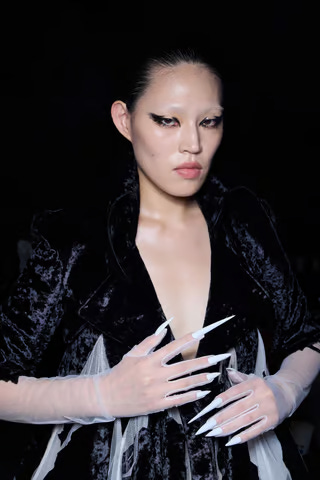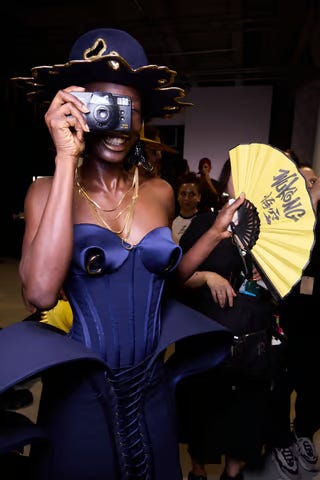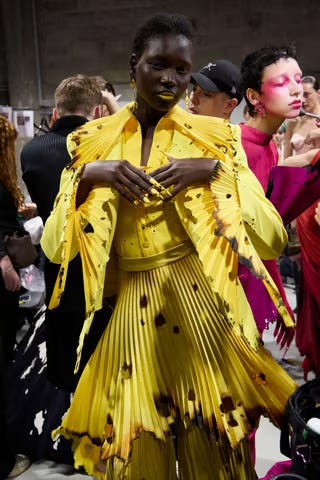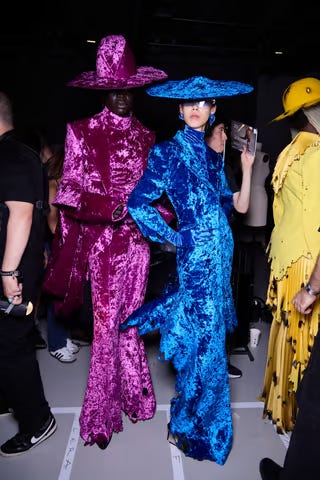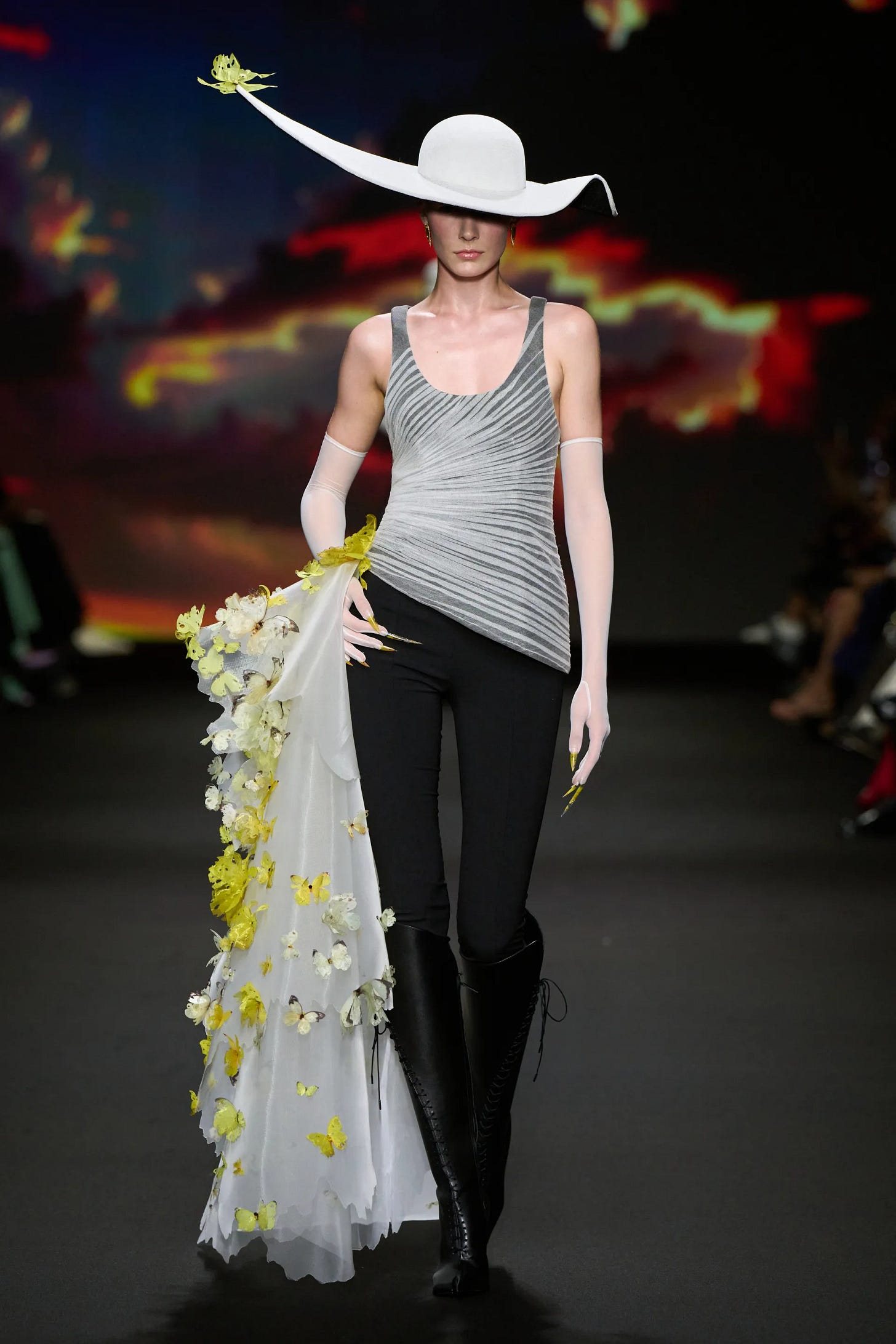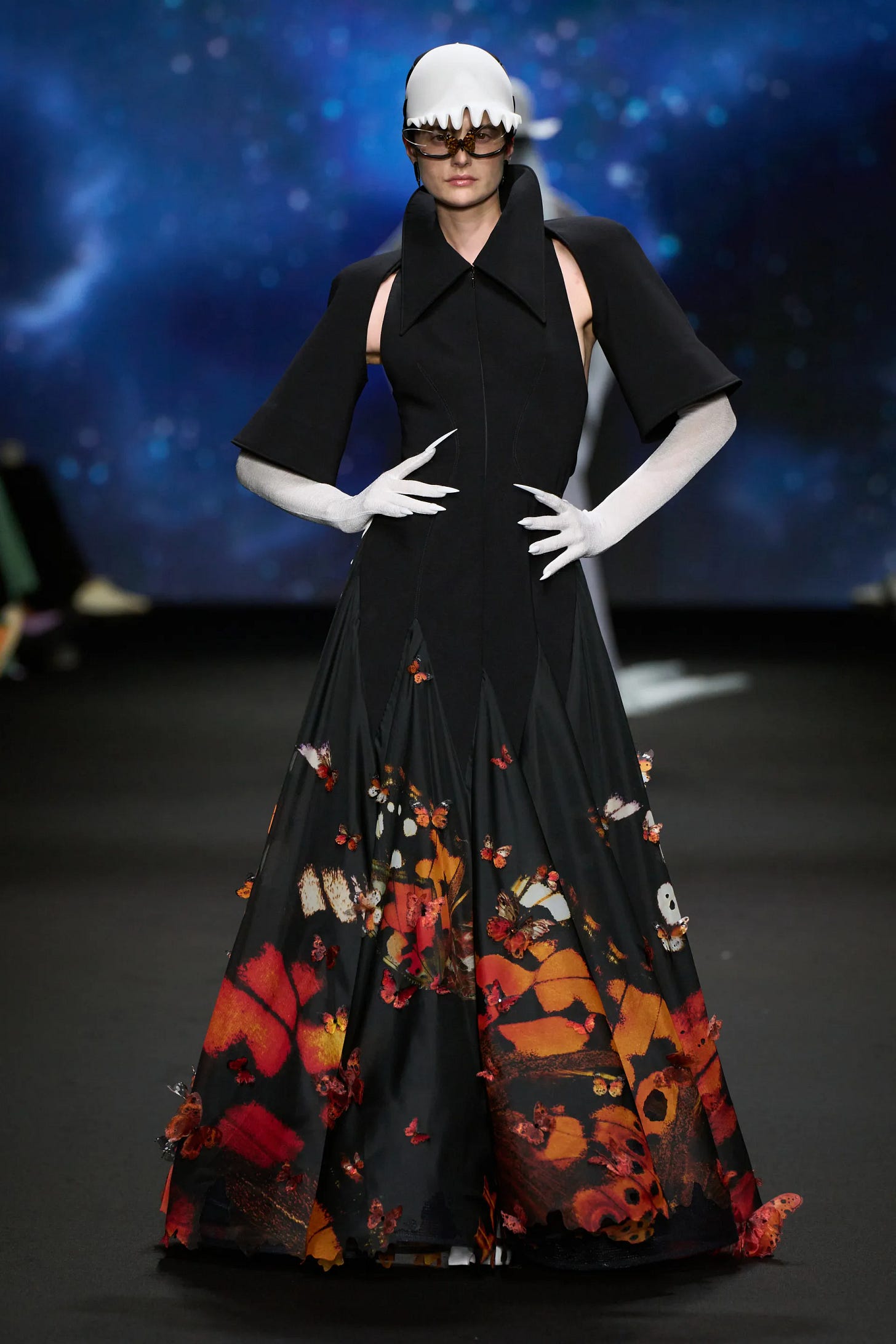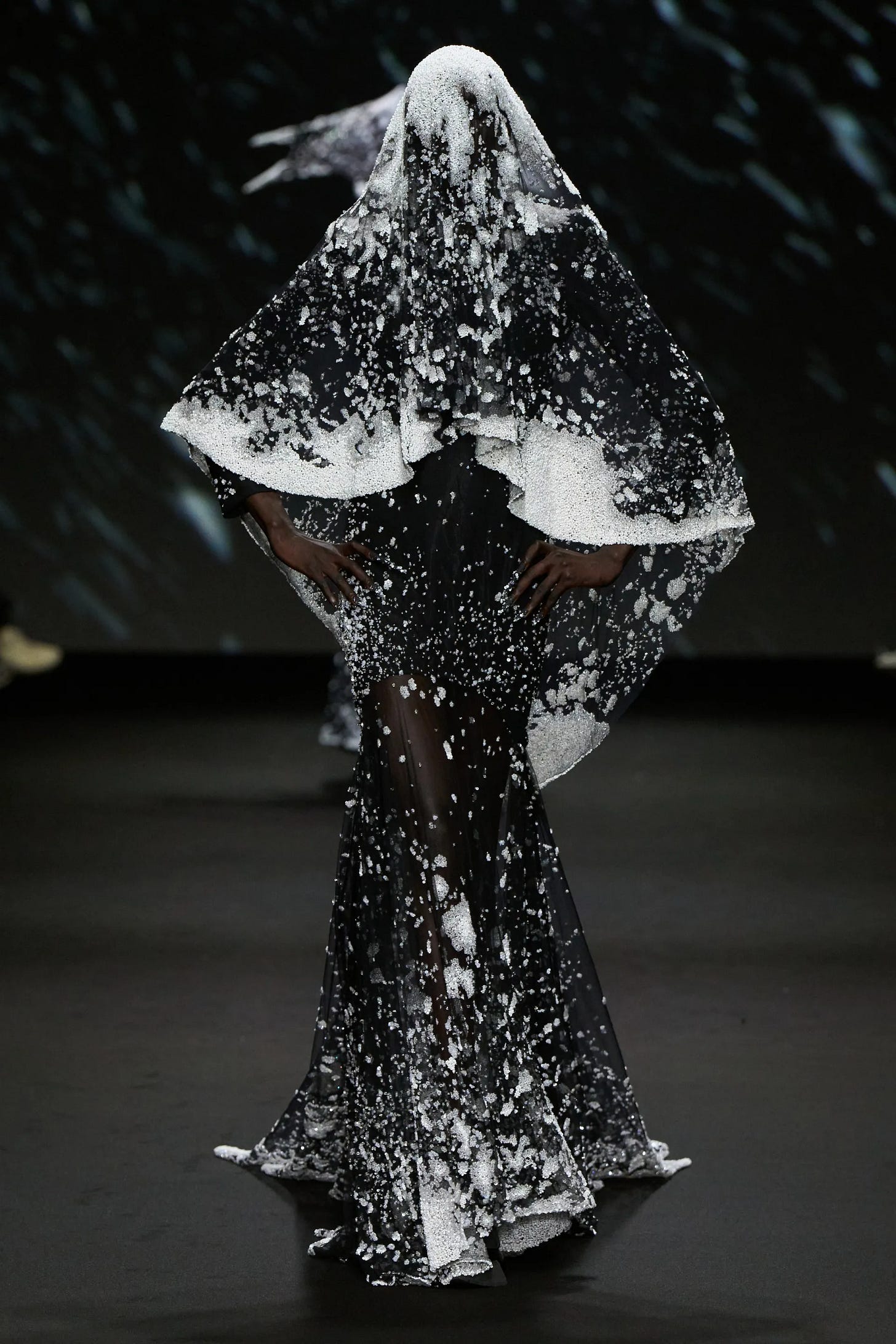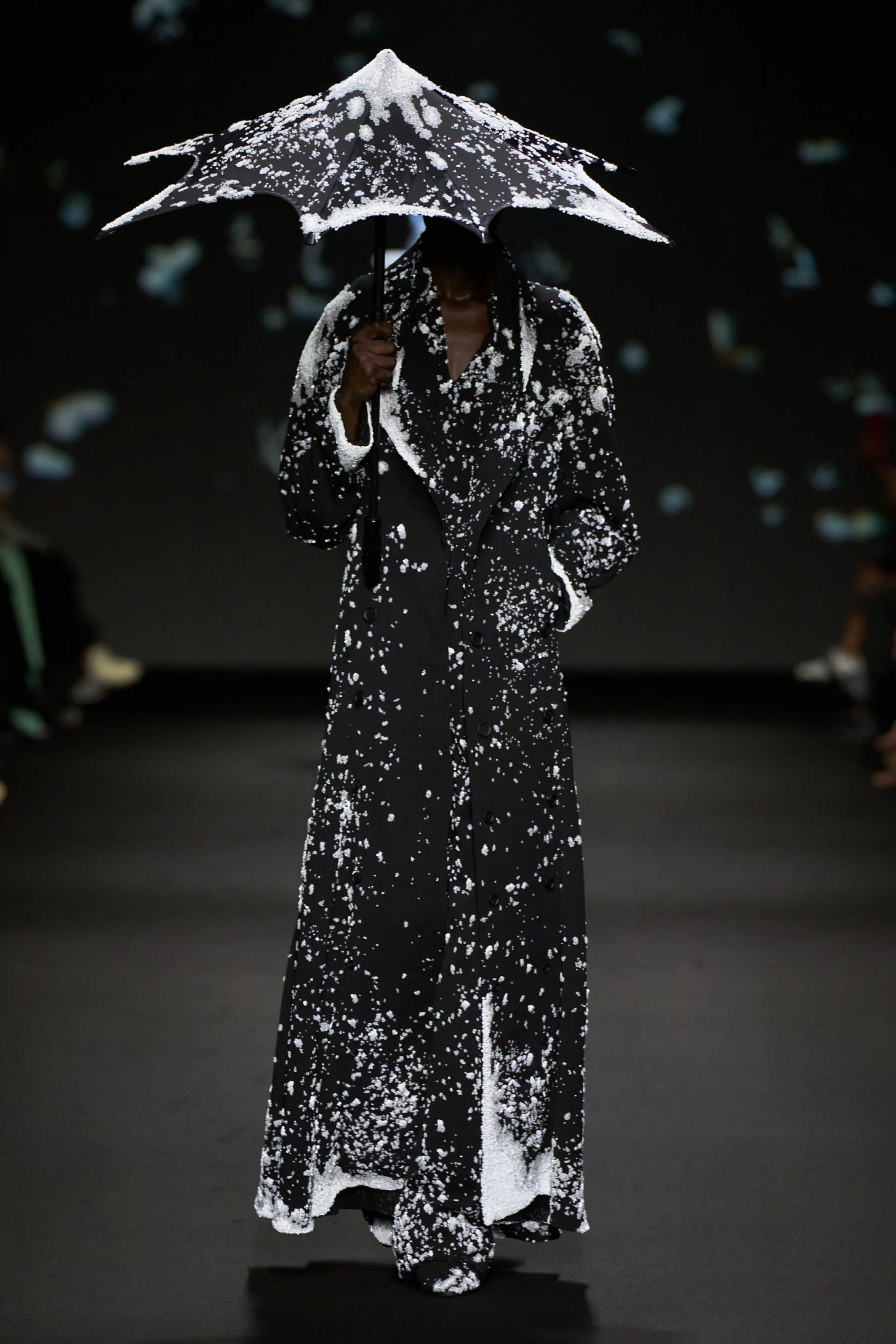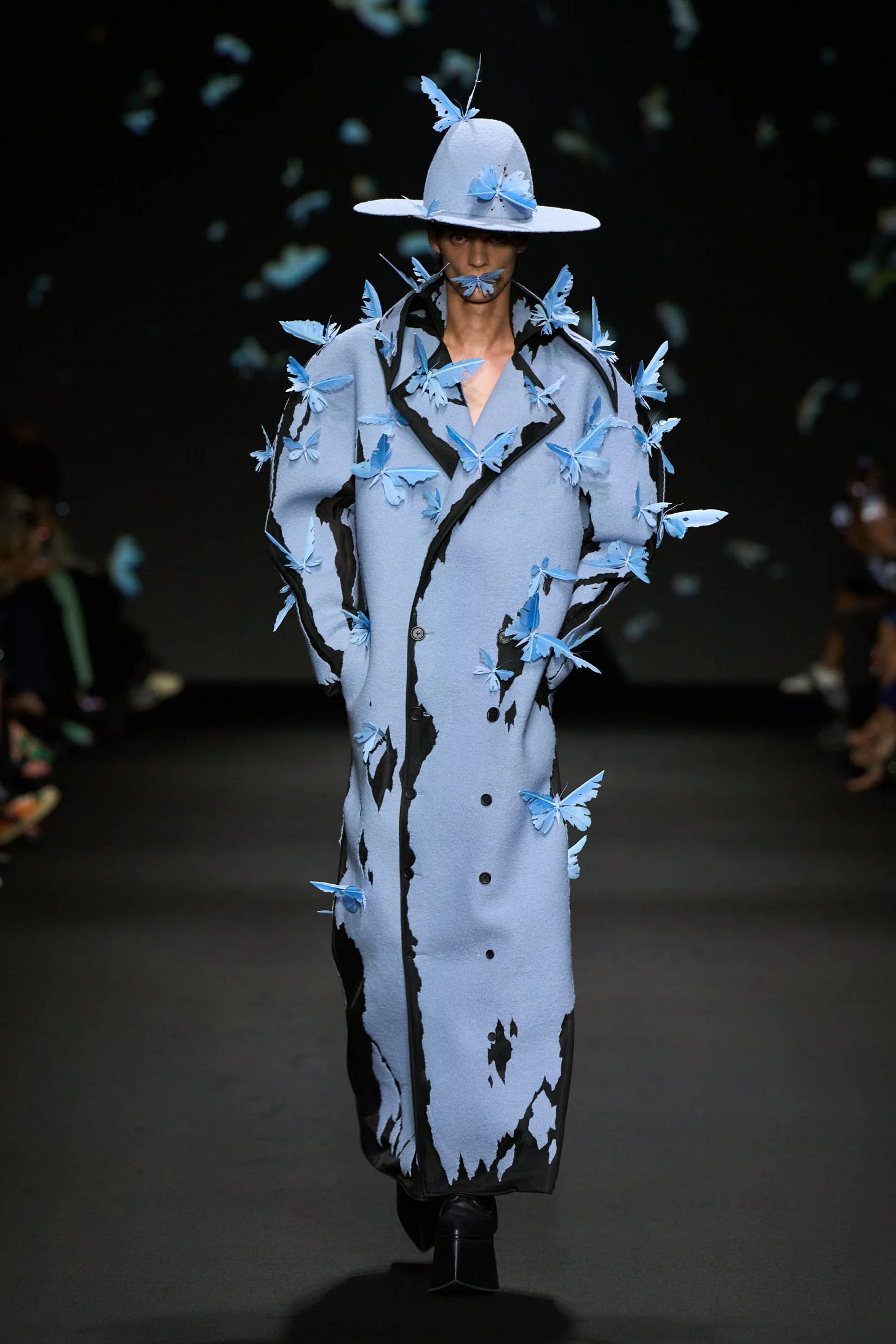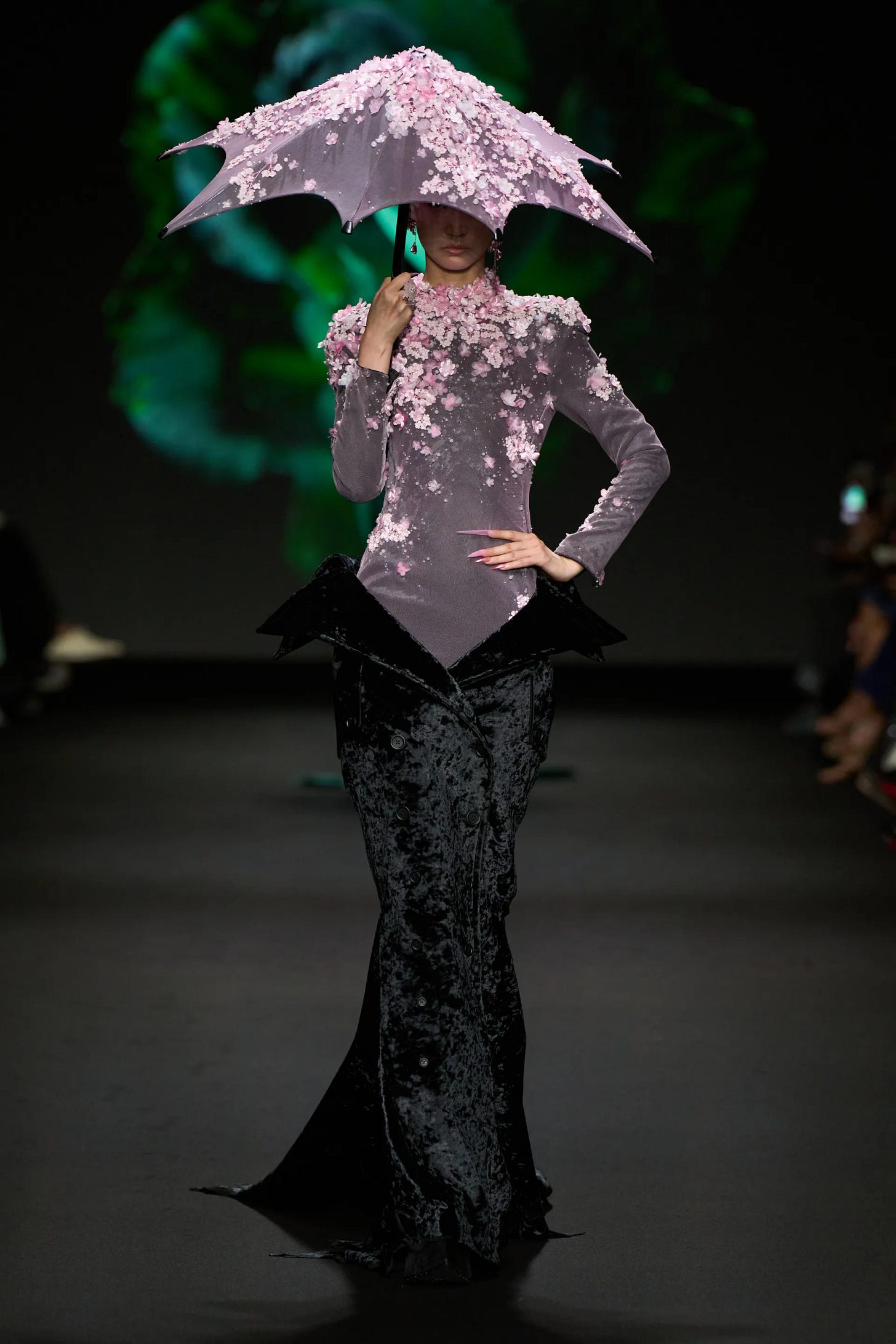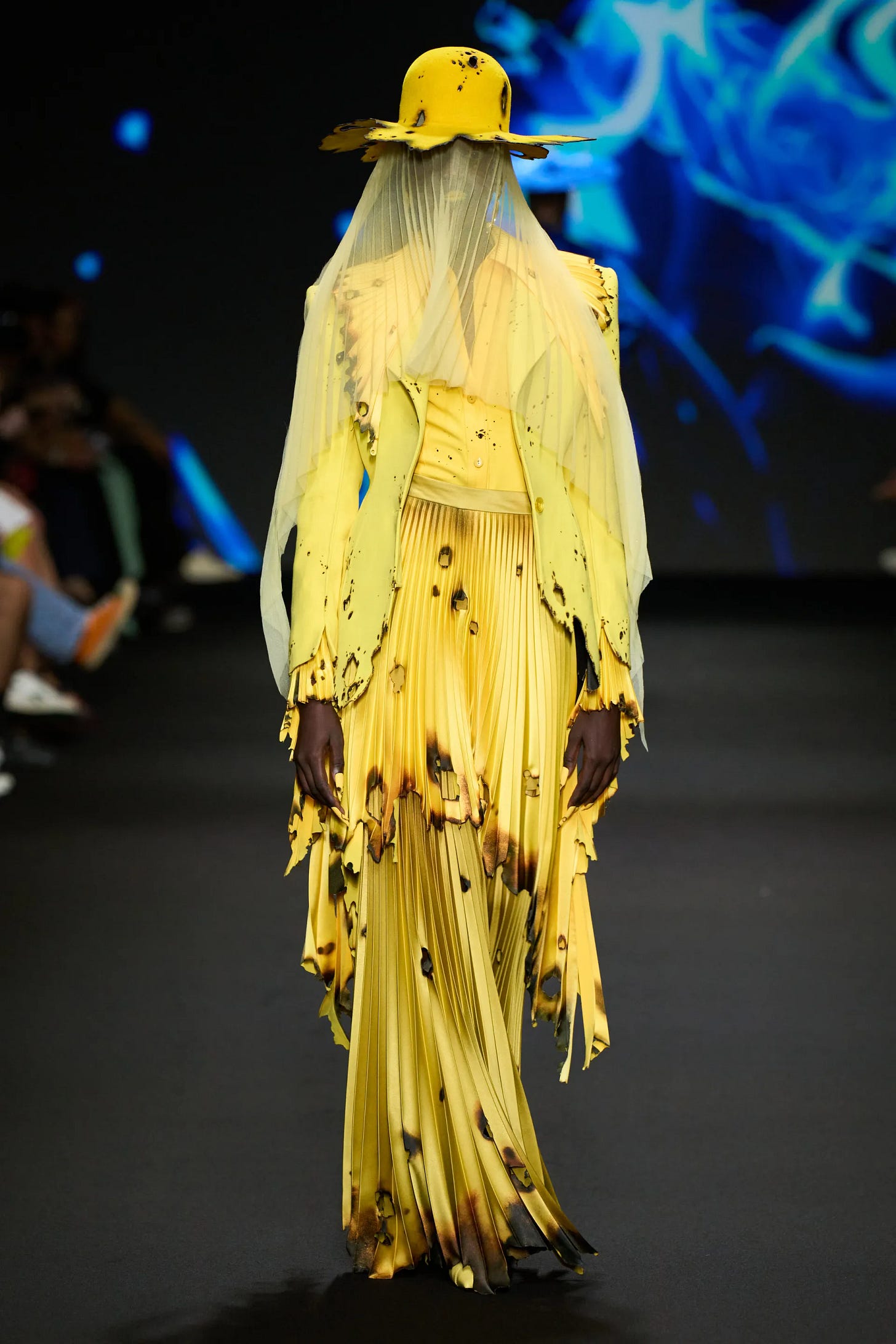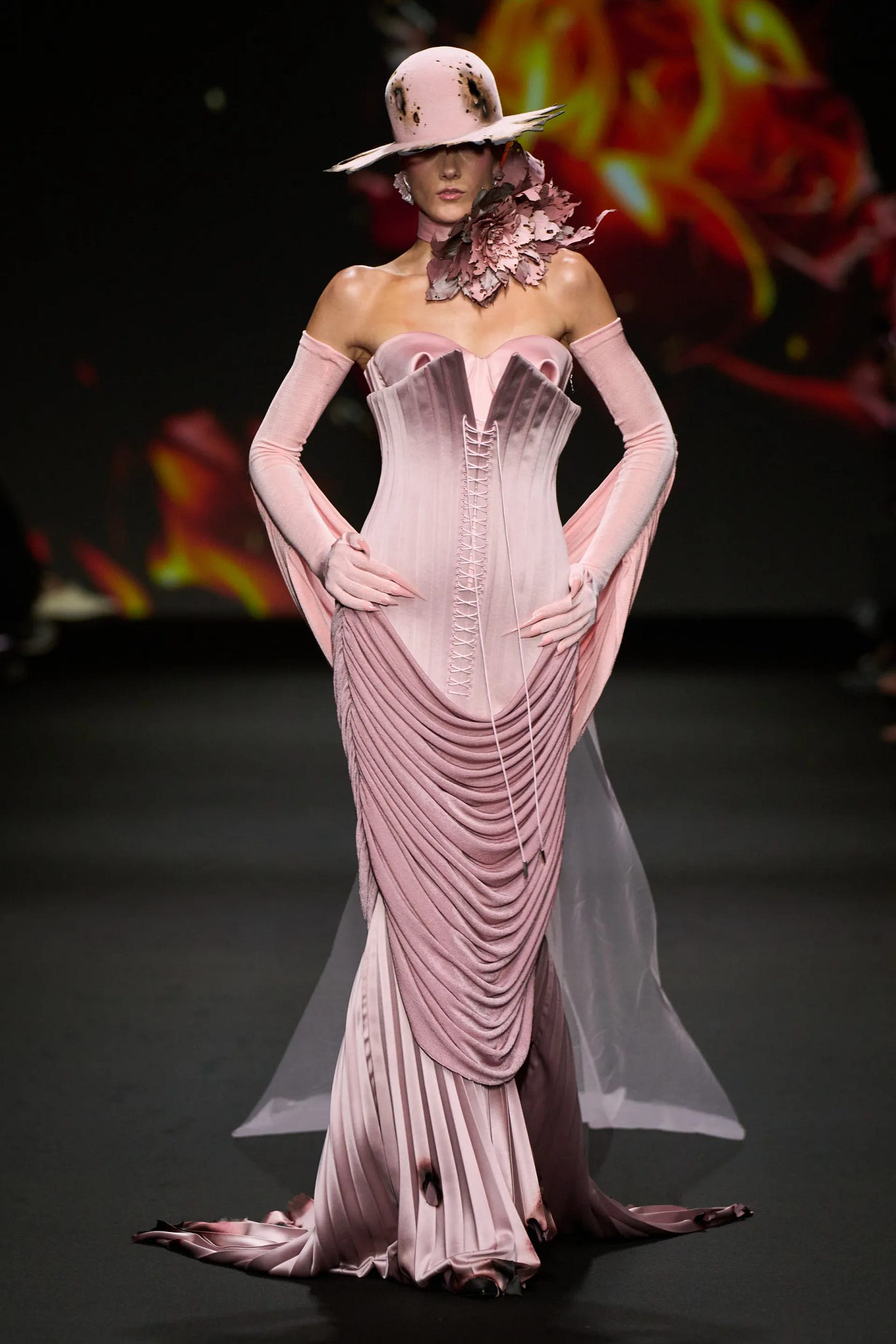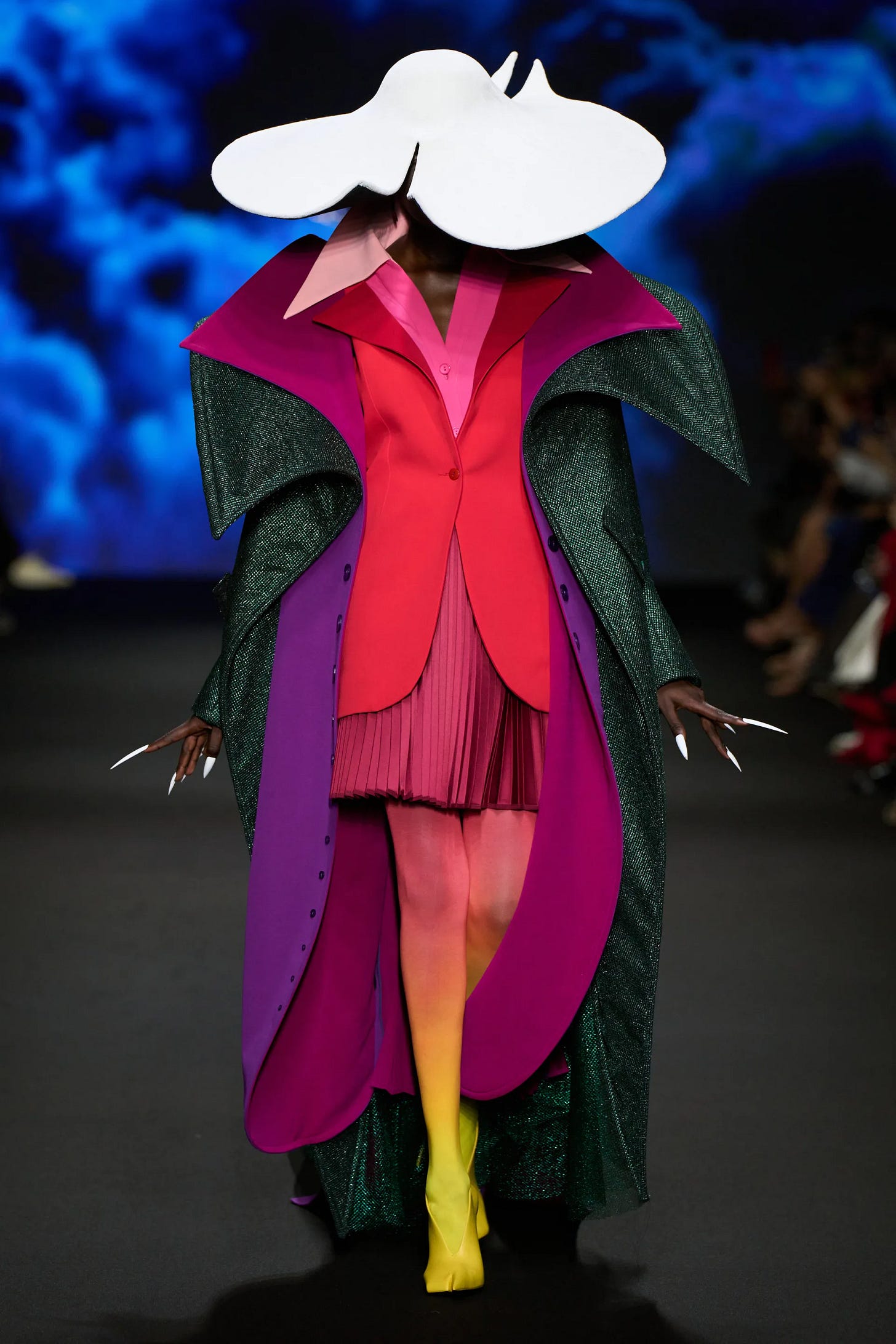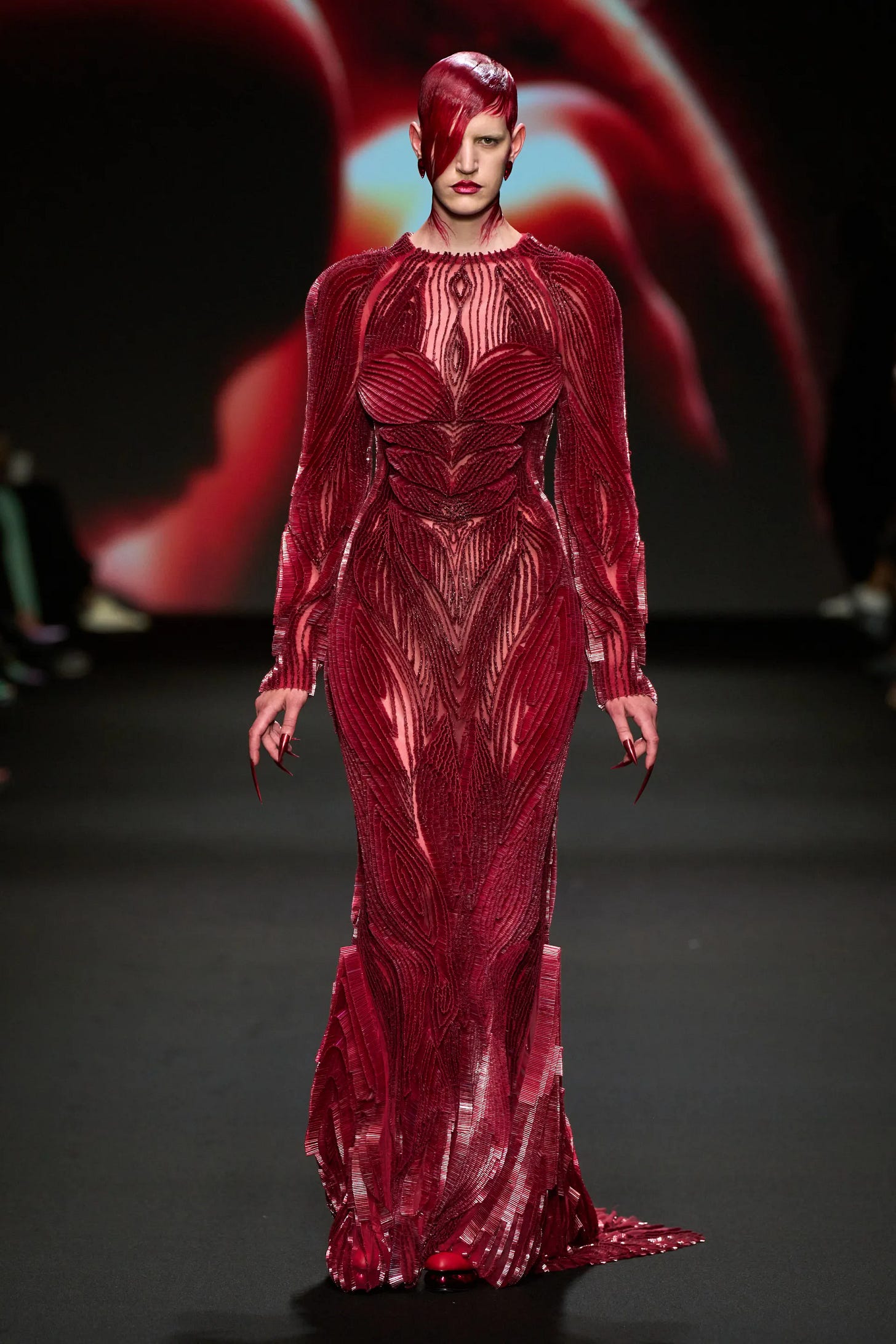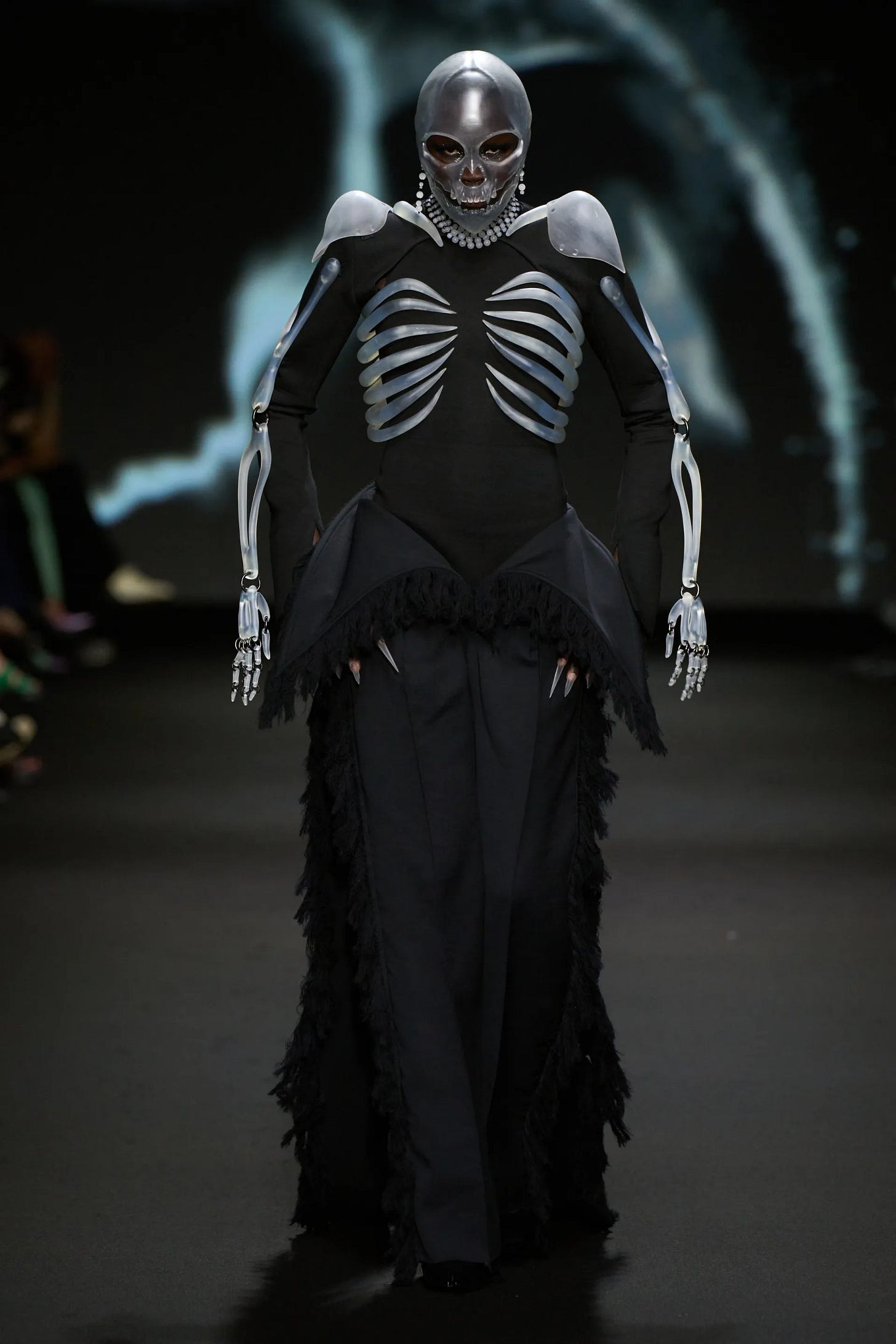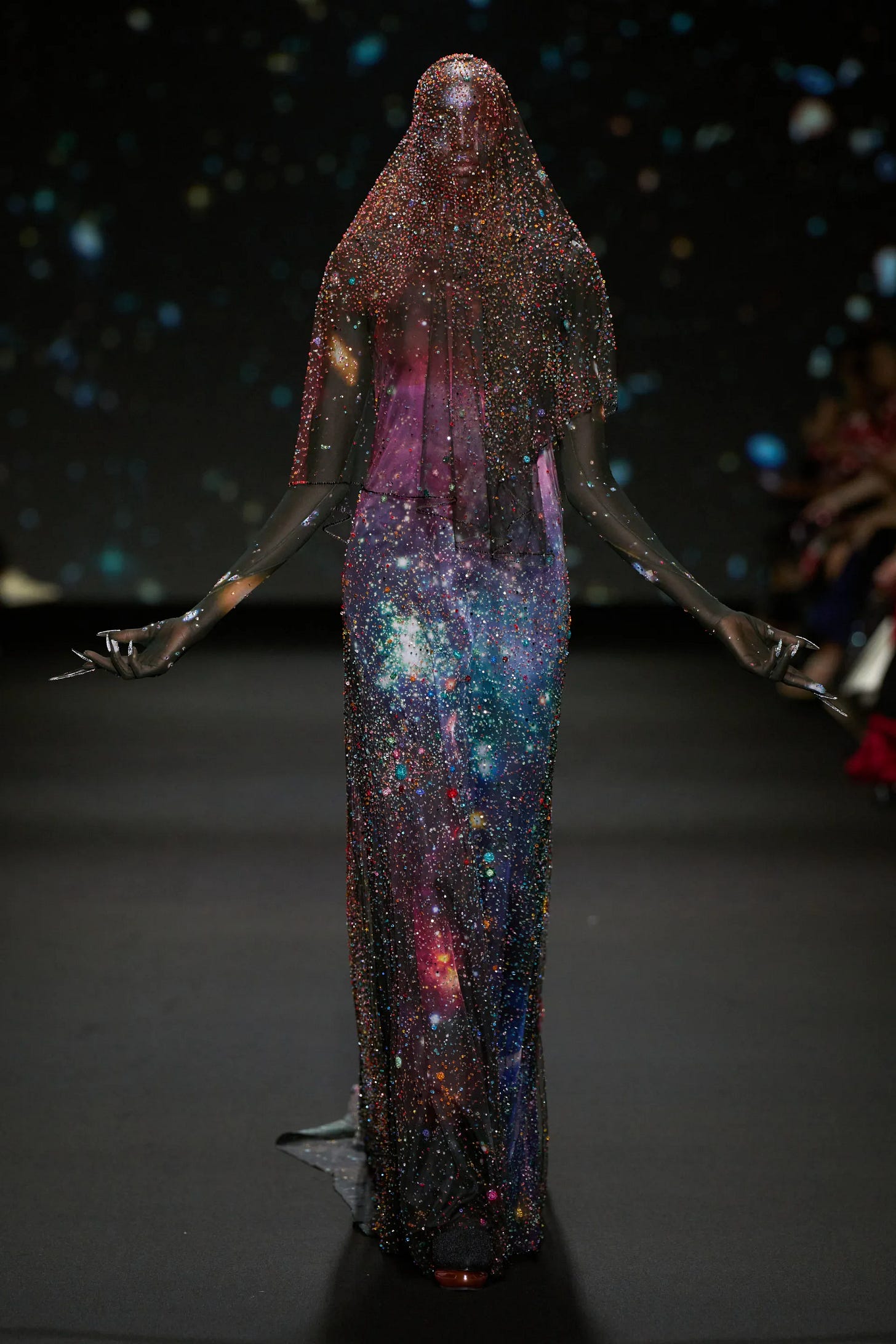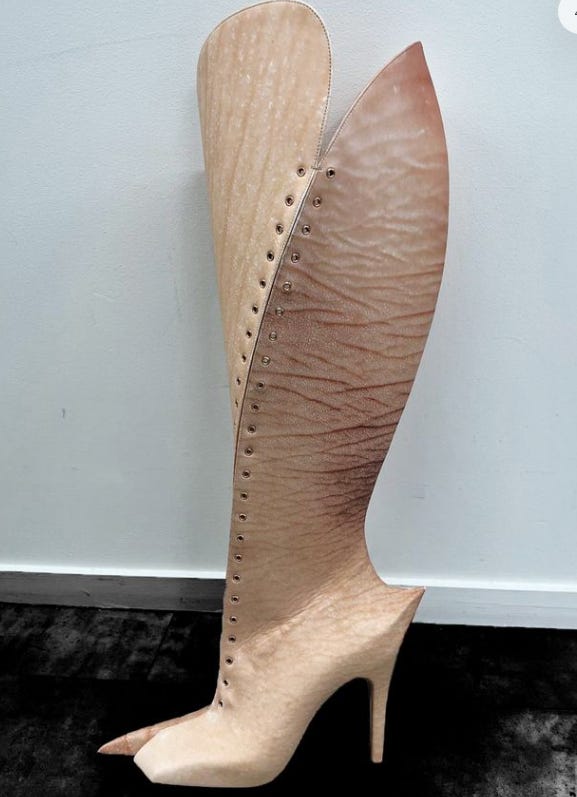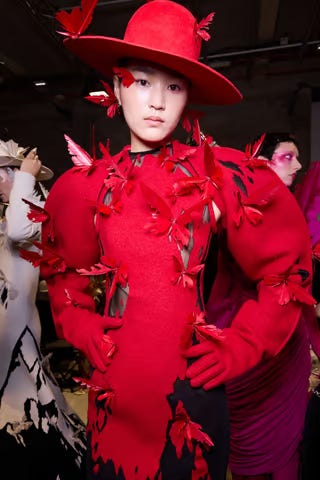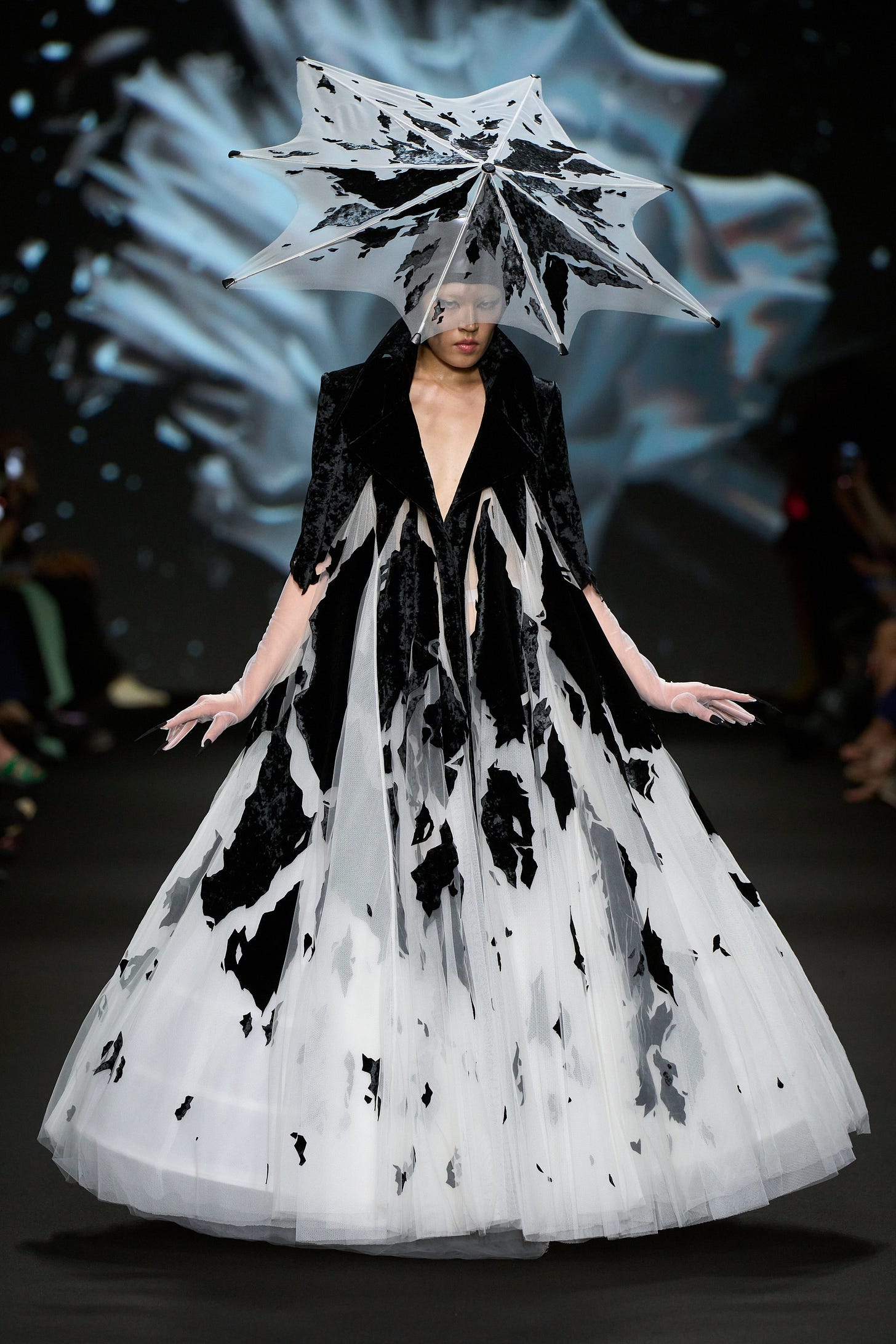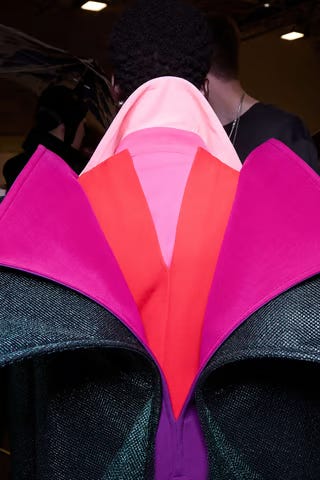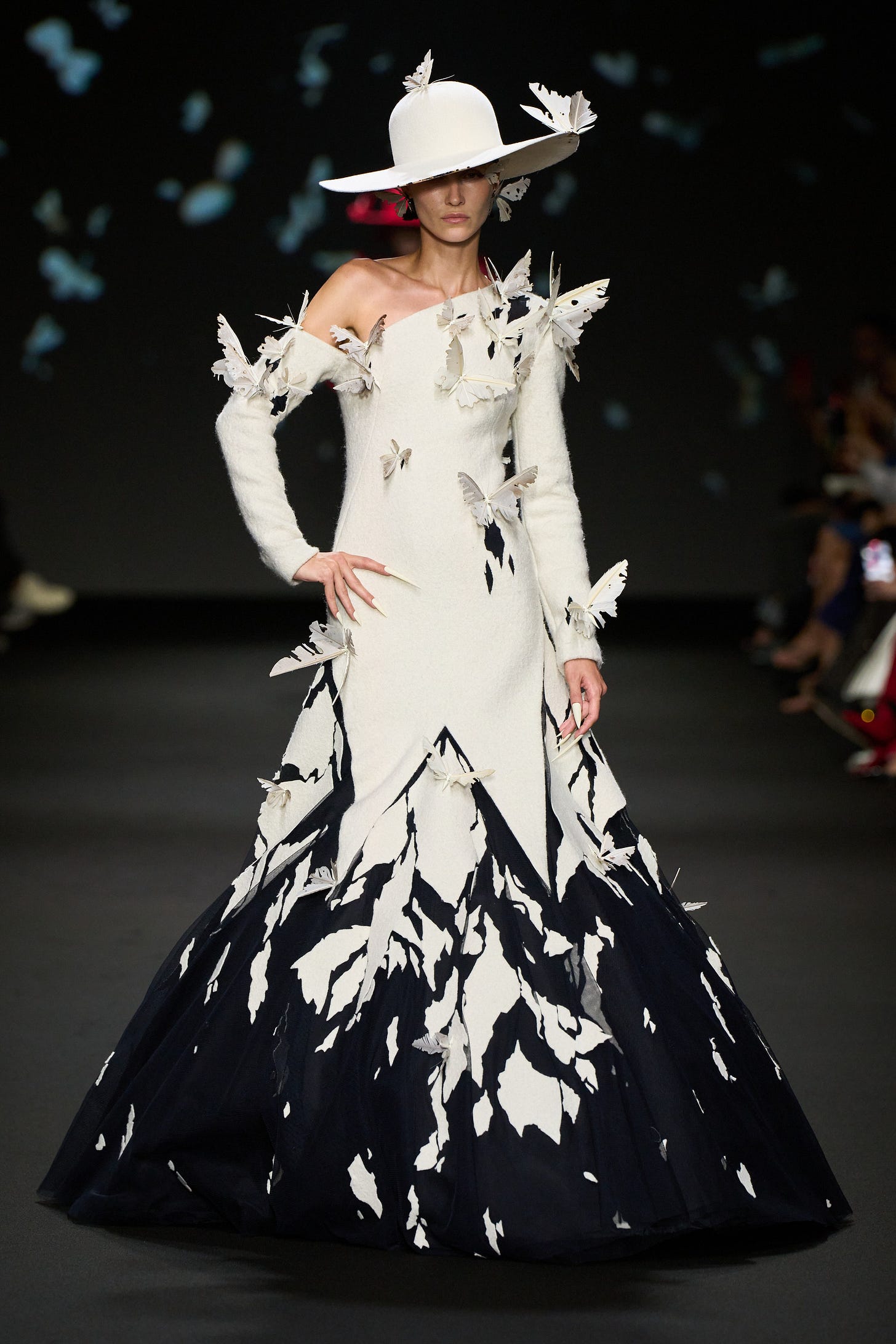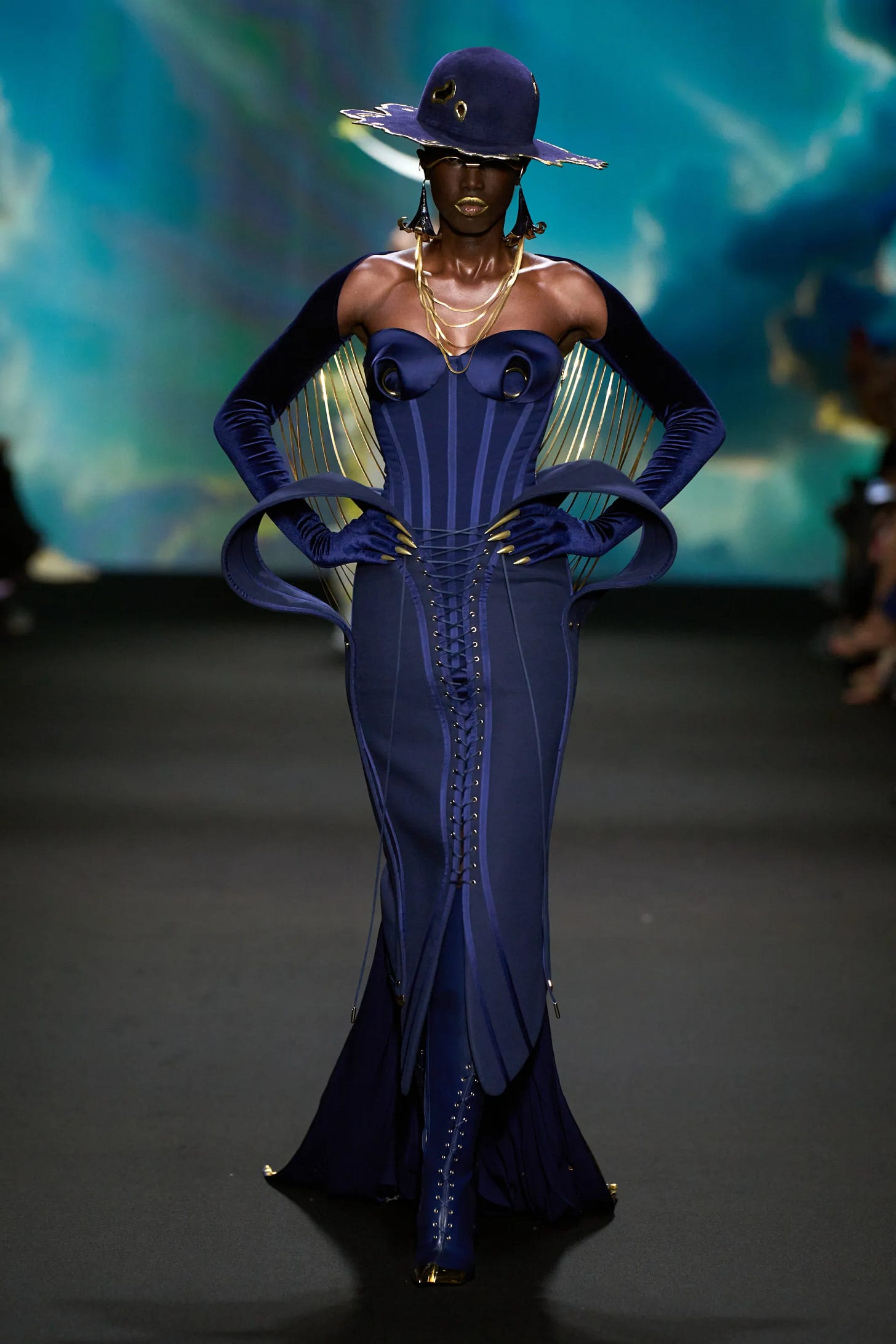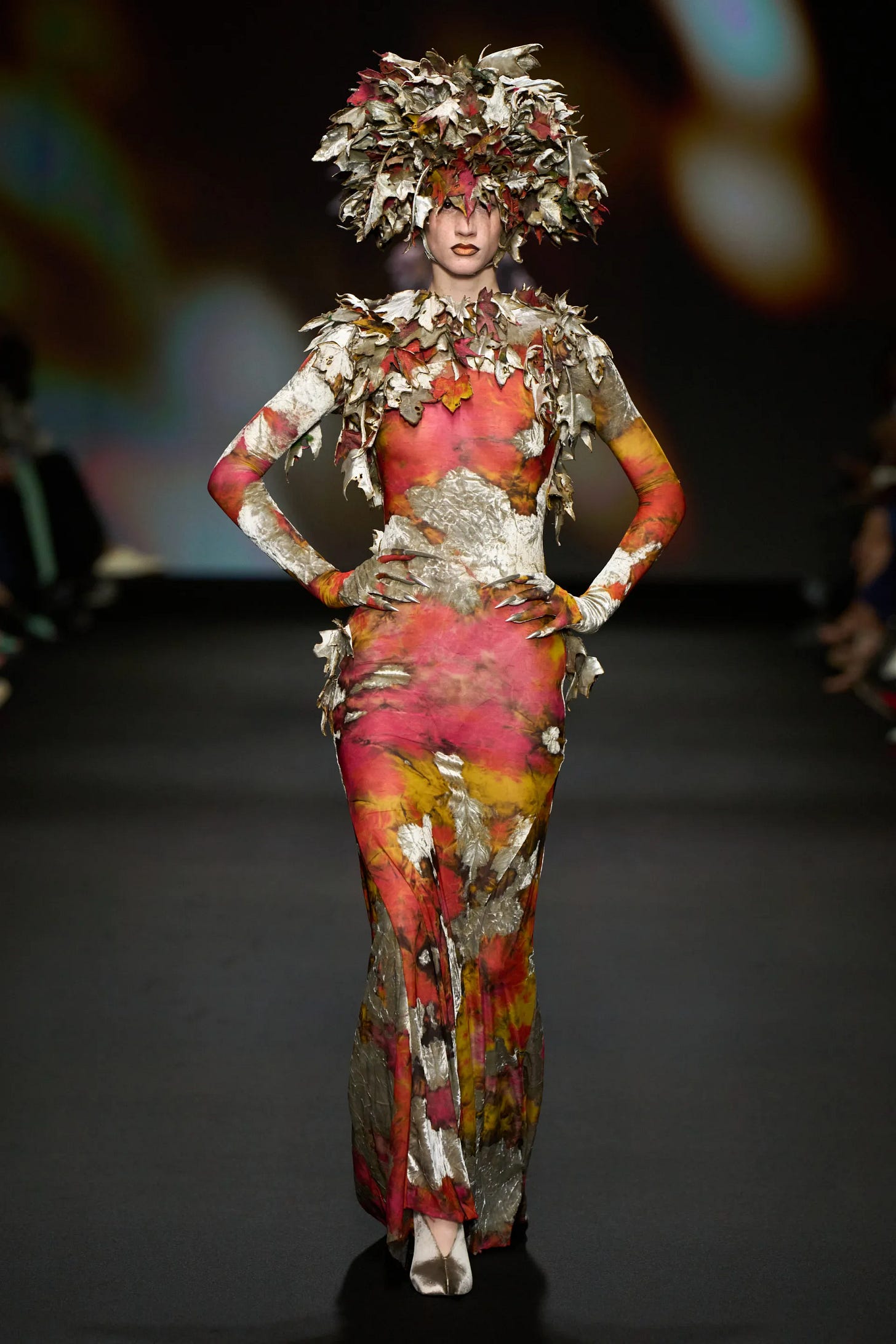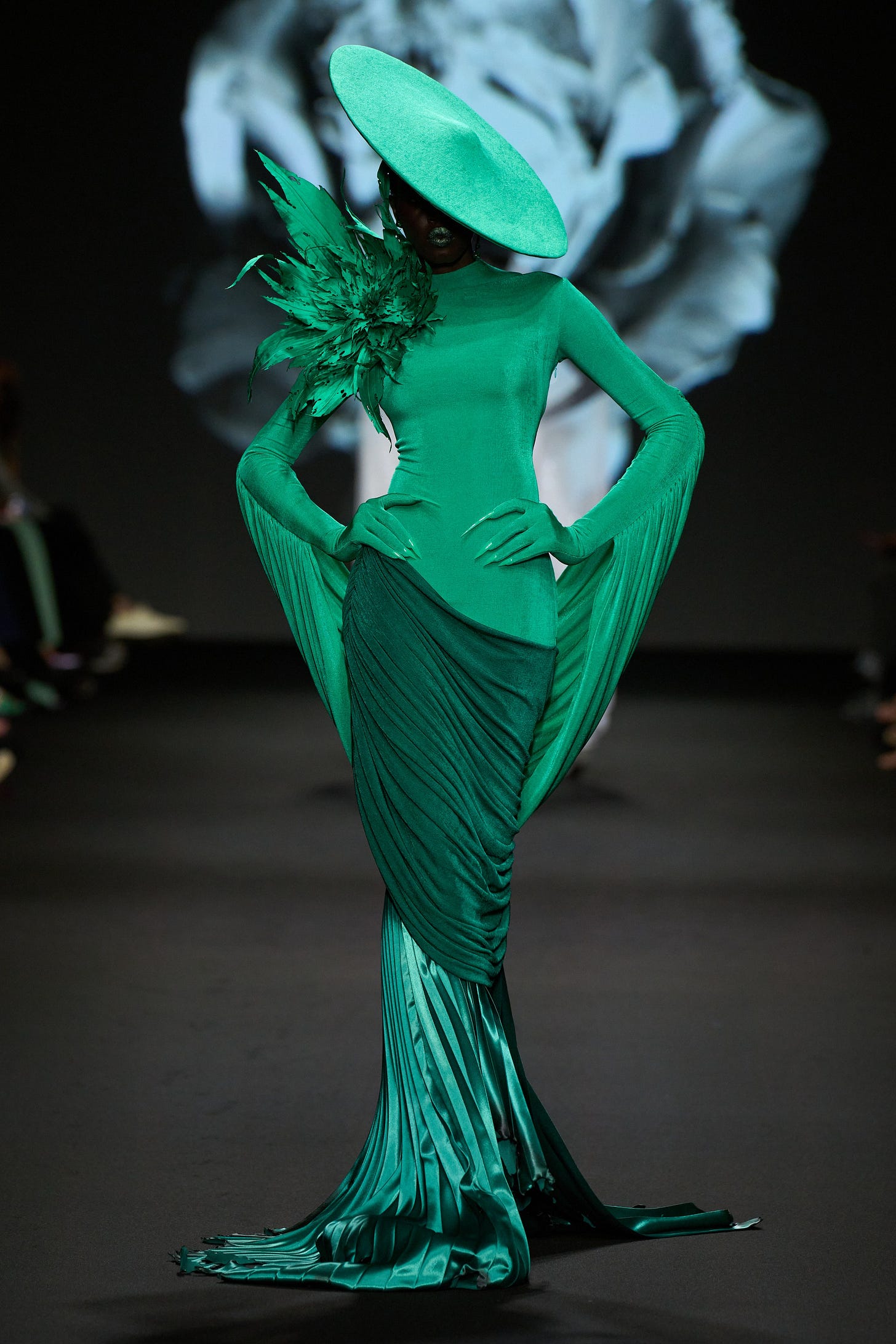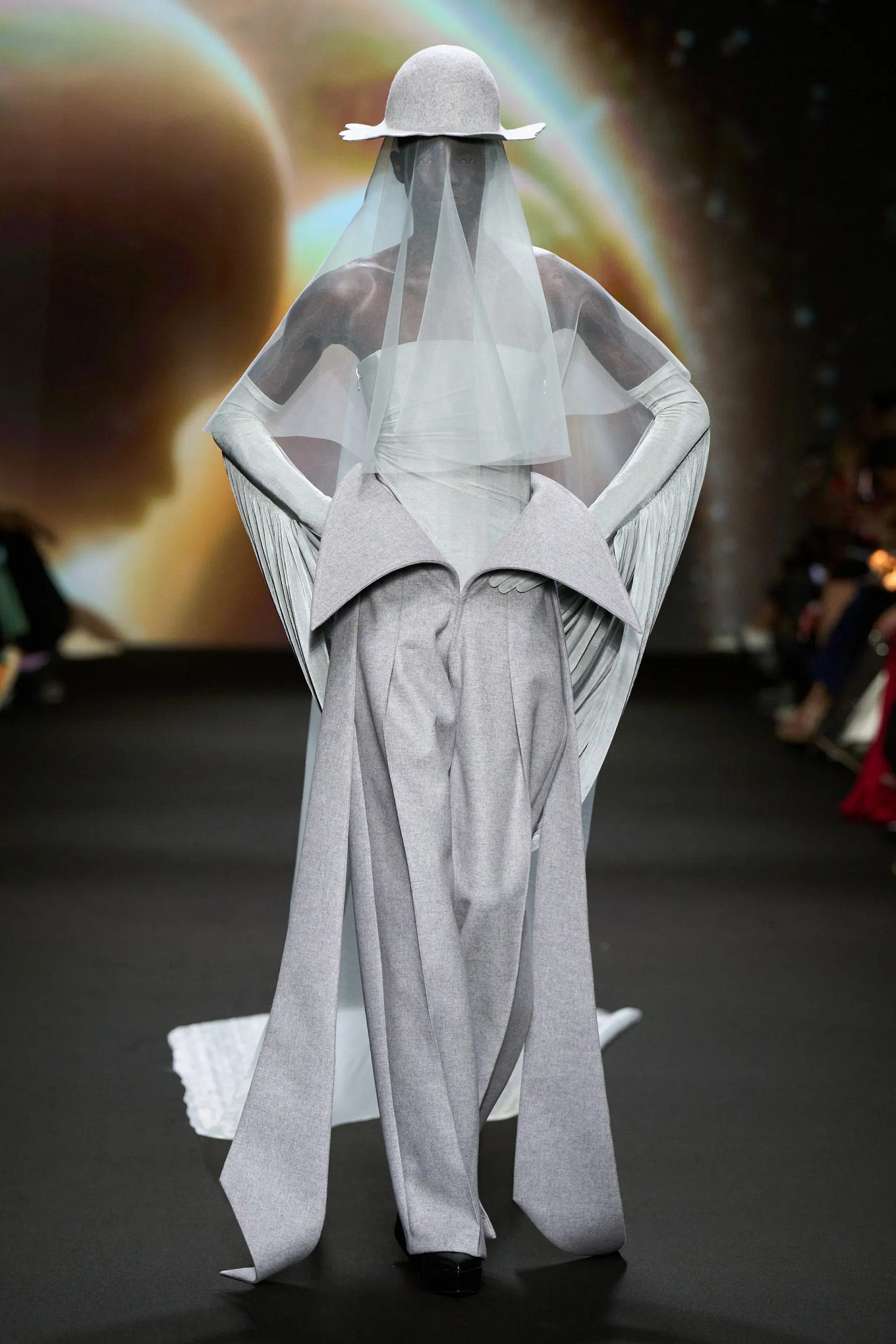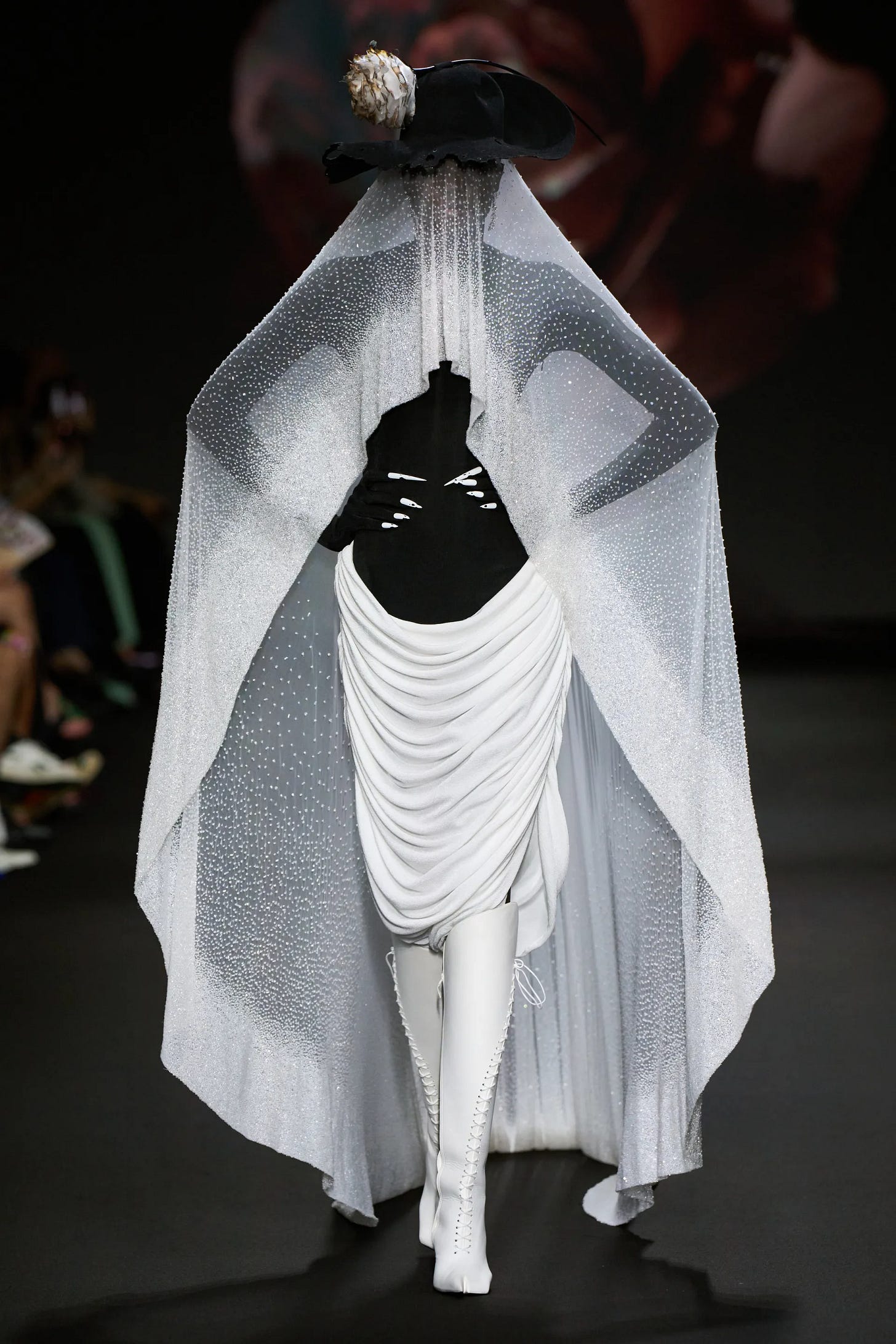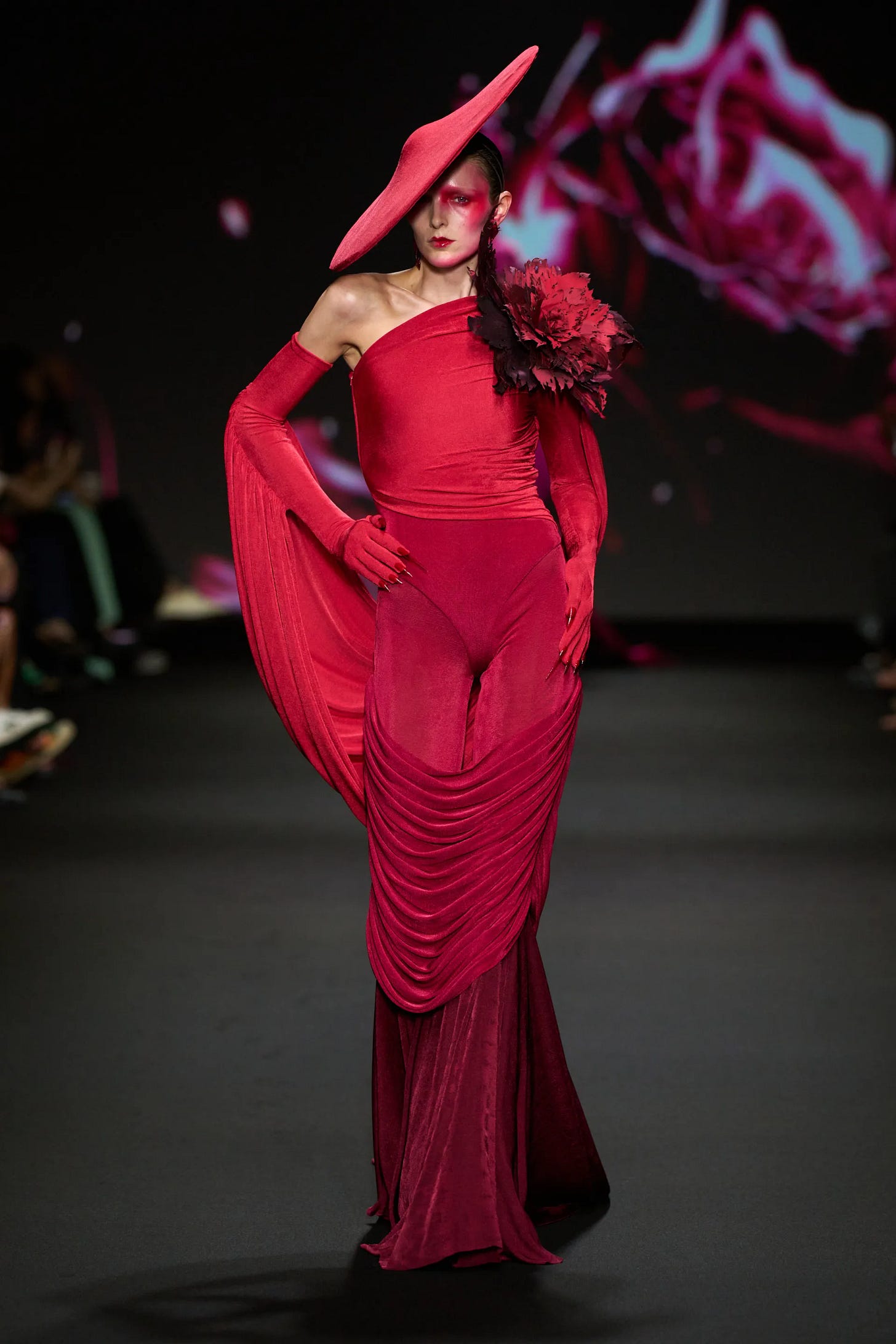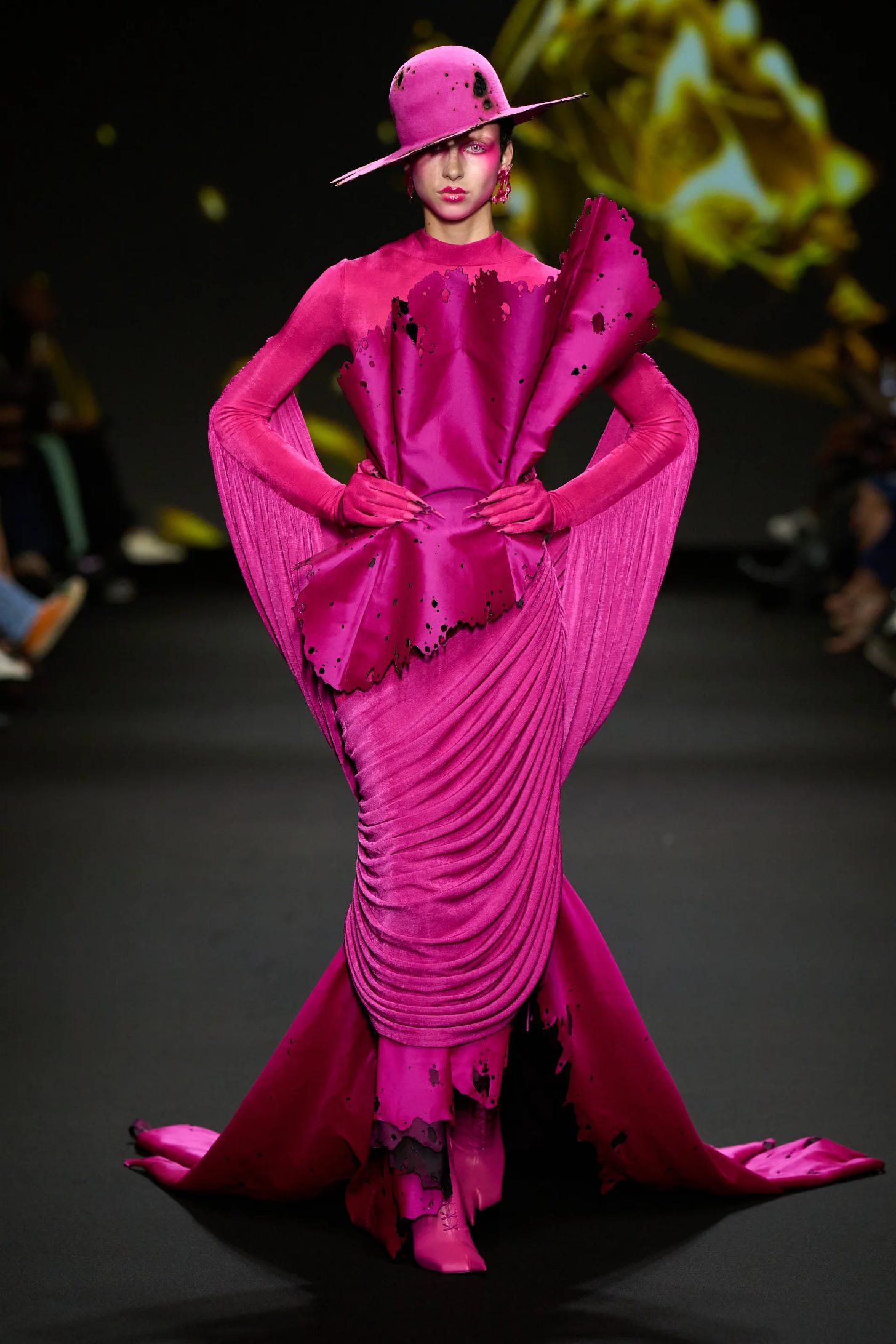Robert Wun transported the venue of his F/W haute couture 2024 to a fantastical and whimsical land, beaming with extraordinary shades of colours and extravagant illustrations. He delved into the depths behind the surrealistic transience of the beauty of time and couturial works to celebrate his label’s 10th anniversary. In this F/W 2024 collection titled, ‘Time Today’, he pinpointed how the most beautiful things in the world, too, wither, decay, and disappear with time. He found inspiration for this collection in a series of philosophical questions he asked himself which ultimately acted as the touchstone for the metaphorical extravaganza he constructed. He said he wanted to reflect on why he had been doing this for so long, why he still wants to keep doing it, and for how long. “I asked myself why I do fashion, and what does time mean?” And the realisation he got was, “The answer is to accept that one day everything ends— and that’s okay.”
Wun translated the concept of time passing through the universe— eventually ageing and decaying everything that it touches— into wearable couture art by envisioning it as a demonstration of the progression of seasons. For him, he explained, time limitations have always fuelled creativity in everything he produces. He doesn’t believe in the saying that instructs us to ‘live every moment’—describing it as a cliche— because of the fear it ends up fostering to live up to a certain pre-conceived notion of this so-called moment we must ‘live in’. If we fail to achieve some sort of greatness in this “once in a lifetime moment” — to achieve the society-deemed correct scenario— the chance to do something might disappear at any time, and eventually, it ends up creating a sort of toxic, machine-like obsession to not falter living up to this standard. Therefore, Wun says “What you’re doing you can only do it once, so better enjoy it no matter success or failure.” and to make the one life we have as meaningful and enjoyable as we can.
This couture season he laureated the runway with an extravagant burst of colours, with hues like bright crimson, burnt orange, sapphire blue, pink blossom, etc. The 25 looks that he produced all held the essence of capturing a singular moment of nature in one frame— to represent momentary pauses of time in all the happenings of trinkets in nature— which may not hold as much importance as in their happening alone but holds great value to someone who recognises the beauty it holds in its being, like a butterfly landing on your hand while you’re sitting in the garden to feel the morning breeze. Things like these are minute in their beings but to experience these is like being touched by the destiny of nature, think about it like the improbability that you got to be a part of the route of that butterfly, and at that moment when it landed so closely, for you, time was paused and all you tried to absorb was the shape and colour of its wings in complete mesmerisation sheerly by the fact it landed upon you. This poetry is what Robert Wun tried to capture in all the couturial pieces he produced and beautifully encapsulated these elements in all the threads he wove. Looks 19 and 20, personified the splurging of life and beauty from their making, and were inspired by the moment a butterfly landed on Naomi Osaka during her match. The grey-hued draped tulle top with a long organza trail from its bottom edge was embroidered with 595 yellow silk butterflies with torched wings— it was truly ephemeral and a great inclusion in the collection. These looks were embedded with a hybrid approach of sportswear and evening wear. Wun described it as, “A wonder of destiny ignited by a simple touch of nature, as if time itself has stopped and all are in awe”, in his collection notes.
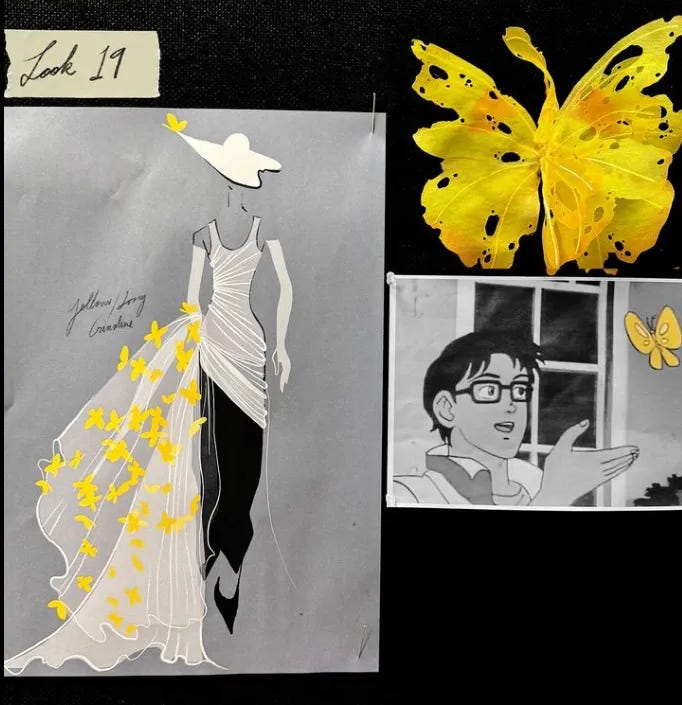

As the curtains were pulled up for the show to begin, the first few looks demonstrated the spectacle of the passing of seasons— which too begin and end with time. The essence of the passing seasons was emanated by the inclusion of blossoming petals, humongous blooming flowers and vivid butterflies, leaves that brimmed with life in the spring and their transition to withered and brittle shells of life as autumn approaches— losing their vernal greenness — and the unalterable and perpetual start of winter with frost and snow. Wun commented on the collection, “From the first snow to the last fallen leaf. From our first heartbeat to our last breath. It is all perfect because it will all end, that is the beauty of time.”
The opening look signified the first snowfall of winter, it was a majestic veiled black gown with thousands of crystals embroidered all over the veil, the bodice, the skirt, and the trail of the gown. “It’s winter, a season that makes people more reflective, so I started from there.” Wun offered. The encrusted crystals were pure white, rendering a pure snowy effect on the volcanic black hue of the gown— it showcased the exquisite craftsmanship that must have been put into the making to achieve an effect that seemed like it was real snow gliding across the runway and falling through the veil. This look was a testament to Wun’s envisioning process from all the dress angles, the way the crystals were embroidered in varying volumes over different places— to achieve that true ‘snowfall-on-the-mountains’ effect— to the wholeness of the silhouette itself. This similar encrusting and layering of white crystals to resonate snow was applied on a slender trailing coat which was constructed using sort of a kintsugi technique, shredding apart and mending back together, to achieve a craquelé effect. It was paired with tailored pants and a pointy Chinese umbrella which had also been embroidered heavily to resemble frost— even the shoes were adorned with snow-like crystals— to make it seem like the model was truly walking in pure snow. These two looks truly resonated with the first fall of the winter season and evoked deep feelings— as Wun desired to impart from the inclusion of snow— of an end in the timeline of our lives, a certain kind of emptiness and isolation, that winters usually make us feel. Models drifted on the soundtracks of Japanese animator Hayao Miyazaki’s films, out onto the runway against changing multi-media backdrops of decaying flowers, fire, and galaxy motifs— representing the death and rebirth of the seasons and emphasizing the circle of life.
As winter comes to an end, spring emerges, representing hope for a new life, an allusion to a new beginning and blossoming of beauty and colours. Wun emulated this with protruding butterfly appliques, humongous blossoming flowers and bright colours— all these were a common theme to the entirety of the collection, although in different forms. The first look, representing the season of spring, was a slender powder blue coat constructed using the kintsugi technique with numerous butterflies protruding from the coat which resembled life emerging after a hard winter— metamorphosis and nature’s reawakening. Wun included Chinese blossoms, intended to be symbolised as harbingers of spring. Resembling this ‘blossoming beauty’ was a tight-fitted bodice embroidered completely in pink blooms with a sinuous black mermaid skirt and an umbrella accessory which too was covered with embroidered pink petals. This look made us all experience surrealism— as if the model was walking in a field of cherry blossoms as they rained down when the wind blew, filling the air with the sweet scent of pollen— and honestly, it transported me to the countryside of Japan in spring. Wun said, “In Chinese philosophy, flowers are beautiful because they aren’t meant to be forever. If they’d blossom forever people wouldn’t find beauty in them.”
The proceeding looks tapped into the theme of ‘decaying beauty’. These looks echoed from each corner of their construction how time erodes all entities as it progresses. The decaying was emphasised and made apparent by burning and slashing the fabric deliberately in all these pieces. Wun wanted to capture the intricacy of life slowly withering apart, of how the most extravagant of the blooms slowly erode from their vibrant brilliancy into the intense blackness of the end. The most significant way to capture this moving into the black hole of the end of life was by embodying it through visibly burned fabrics— a technique of fabric manipulation. Wun explained, “We scanned the burn marks we’d done on a piece of organza, then we printed it on silk and did further burning on the edges to emphasize the effect, burn, scan, print, and then reburn.” We saw wide-brimmed hats— Wun’s signature classic— veils and geometric silhouettes representing flora, pleats of the gowns and the trails all with burnt holes, damaged and scorched hems and blackened areas— all of which was a metaphor for the decomposition of life.
One of my favourite looks in the decayed beauties’ fragment was the yellow coated dress, with two layers of pleating in different lengths and volumes, paired with a wide-brimmed hat with scorched edges and holes in its surface and a long bust-length veil in a translucent baby yellow hue— also with burn marks. The whole silhouette of the look was covered with the same scorching and burning. Time’s erosion on every living being was rendered by visible burns on the hems of this bright yellow three-piece in swishing silk, voluminous and entirely plissé. It emanated a story of a yellow poppy flower that is withering as the weather changes and its purpose in nature ends. Just like Wun has tried to impart in the entirety of the collection, what I got from this look was that regardless of the poppy flower withering and dying and no matter if its life was short, it spread joy and beauty in the world whilst it stood tall and swayed with the wind and spread its pollen around— as its life ends, a new one begins.
I was absolutely enchanted with the allure and exquisiteness emanated by the powder rose bustier gown with corseting details— as a centrepiece— that accentuated the waist of the model and gave it a theatrical seance. It omitted elegance from all the wires of its construction with a heart-shaped neckline and the meticulously gathered and draped fabric that gave it a multi-dimensional effect as it cascaded down to the floor and flowed seamlessly as the model moved across the runway. The accessories which were paired with the couturial gown fit in just perfectly— a wide-brimmed hat in the same rose hue with burnt manipulation, long and fitted gloves that blended in sublimely with the gown and an exaggerated floral neckpiece that, if I might say, integrated the whole look— and added a touch of romantic whimsicality to this beautiful avant-garde creation.
One look that stood out the most to me midst the collection was a quadruple-layered dress with an abstract and formed silhouette. It emanated the essence of the blooming of buds, signifying the beautiful phenomenon of the formation of life. The ensemble was extremely layered with a bold and contrasting colour palette. A pleated skirt in a hot pink shade was donned with a lighter rose shirt, whose collars peeked out from the second layer of a fuchsia-hued tailored fit blazer. Since Wun likes to go the extra mile, he threw on at least 3 more abstract silhouette coats— all marvellous in their craftsmanship— with oversized and structural lapels. The outermost layer was a dark forest green, scaly-textured overcoat with exaggerated lapels cascading down to the hoof-toe heels worn by the model— the texture of the coat was an extreme hit, it added a feel of luxuriousness to the otherwise whimsical elements. Underneath the first layer was a bright magenta coat with an interior lining of pink that added to the elements of contrast and boldness, as well as a fiery crimson blazer with a structured fit. The most striking appeal to this look, which integrated all these elements in synchronicity, was the pair of gradient tights that blended seamlessly with the lime-yellow heels. All the aesthetics that Wun integrated into his creations— from the whole silhouettes to the tiniest details— made me compare the runway to the tale of ‘Alice in Wonderland’. This showcased Robert Wun's mastery in bringing out life from his pieces.
In this extravagant demonstration of the righteous parade of life, the final 4 looks— that can be deemed as the showstoppers— were translated as a progressive stripping of human life. Starting with the physical remains of the body— the skin, the flesh and the bones— and then ending with translating the spiritual entity, the subconscious, and the soul as the metaphorical embodiment of being fused as one in the vastness of the universe. ‘The Skin’ was a sensational ensemble that evoked the true essence of real skin through the delicateness in its construction, the texture and the fluidity embedded in the fabric. It held intricate and beautifully constructed pleats that stretched vertically and horizontally in an organic colour palette. This was combined with the drapery of the one-shoulder cocoon gown. The light brown to warm beige shades personified the natural folds and contours of the human skin covering the entirety of the body— just like this look covered the model completely. The gown was paired with a sculptural headpiece— it was formed to mimic a human face to add a sense of mystery and etherealism— that extended harmoniously into a delicately pleated veil.
‘The flesh’ was a slender sheath gown that was entirely embroidered in bloody red bugle beads which were sewn standing up as spikes, vertically and extending outwards from the dress, to give the illusion of real muscles being put on display three-dimensionally. The extraordinary craftsmanship cultivated an ominous feel in the entire venue with the splashes of the horror genre in its making— Wun, who's an enthusiast of ominousness. The dress was 40 kilos heavy due to the heavy embroidery— much applaud to the model who donned it and walked so graciously. Wun’s penchant for horror was made much more apparent by the dangling skeleton that was mounted on the skintight black wool-silk tailored jumpsuit. It was inspired by the exoskeletons of an immortal being, Wun mentioned in his collection notes, reflecting the desire for immortality and inevitable mortality.
The closing look, ‘The Soul’, held the essence that the soul never dies and returns to the universe ultimately existing there for the entirety of time. The soul gown was a vision of portraying the stars in the universe and can only be described as a heavenly retribution and a visual metaphor for a god-like entity. It was a trailing veiled gown, with layers of tulle embroidered with myriads of tiny multicoloured Swarovski crystals that shimmered in the dimly lit venue. The veil had the greatest density of clustered crystals— all different in size which accurately resembled the stars in a universe— which further extended towards the end of the trail of the gown. It was an interpretation of searching the soul within the stars. It looked rather magical, the fabric of the gown itself was printed with galaxy-like illustrations. “The soul isn’t meant to perish,” Wun said. “It goes back to the universe.”
Wun’s haute couture F/W 2024 collection explored a journey to reconnect with our spiritual selves and to embrace the phenomenon of life through passing seasons and the continuity in the circle of life— from winter and spring to decaying flowers and death to the contrast between the impermanence of our bodies and immortality of the soul in the universe. “It is a search for its meaning, and the time’s effect on the ephemeral world,” he said, “It aims to encapsulate the concept through craftsmanship, where time shines through the art of couture. We wish to take our audience through a cinematic experience, a moment to get lost in time.” In the realm of haute couture where everyone is trying to embody permanence and immortality, Wun invited his audience to appreciate and embrace the beauty in impermanence— his brand's core philosophy— by becoming a part of his eerie world. His collection served as a testament to stunning craftsmanship, a decade of individuality, creativity and innovation, and evocative and exaggerated silhouettes.
